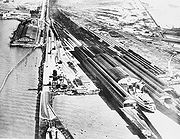
Alameda Mole
Encyclopedia

The Alameda Mole was a facility, no longer existing, that served as a transit and transportation artery for ferries landing in the San Francisco East Bay. It was located on the West end of Alameda (the end facing San Francisco), and later became part of the Alameda Naval Air Station. It was one of three neighboring moles, the others were the Oakland Mole and the WP Mole (Western Pacific). The purpose of the mole was to extend tracks of rail-based transportation lines beyond the shallow mud flats along the shore of the East Bay, until they extended into water that was deep enough to accommodate the ferries that could transport passengers (or train cars) to San Francisco.
The Alameda Mole was used by: (i) local trolley cars (such as the Red Line), (ii) ferries to San Francisco, (iii) regular trains running in a horseshoe pattern (dubbed the Horseshoe Line) to the Oakland Mole, (iv) local steam commuter lines of the Southern Pacific Railroad
Southern Pacific Railroad
The Southern Pacific Transportation Company , earlier Southern Pacific Railroad and Southern Pacific Company, and usually simply called the Southern Pacific or Espee, was an American railroad....
(initially, the Central Pacific
Central Pacific Railroad
The Central Pacific Railroad is the former name of the railroad network built between California and Utah, USA that formed part of the "First Transcontinental Railroad" in North America. It is now part of the Union Pacific Railroad. Many 19th century national proposals to build a transcontinental...
) which were later transformed into the East Bay Electric Lines
East Bay Electric Lines
The East Bay Electric Lines were a unit of the Southern Pacific Railroad which operated a system of electric interurban-type trains in the East Bay region of the San Francisco Bay Area...
. Southern Pacific's electrified trains were not streetcars, but full-sized railroad cars which connected to the mainland by bridges at Webster Street and Fruitvale. The trains ran to both the Oakland Mole
Oakland Long Wharf
The Oakland Long Wharf, later known as the Oakland Pier or the SP Mole was a massive railroad wharf and ferry pier in Oakland, California. It was located at the foot of Seventh Street....
and the Alameda Mole.
Soon after the completion of the Bay Bridge in 1936, the Alameda trains ran directly to San Francisco on the lower deck of the bridge, and thus the ferries and the mole were rendered somewhat obsolete.
In the 1930s Pan American Airways established a seaplane
Seaplane
A seaplane is a fixed-wing aircraft capable of taking off and landing on water. Seaplanes that can also take off and land on airfields are a subclass called amphibian aircraft...
port along the fill that led to the Alameda Mole. This was the original home base for the China Clipper
China Clipper
The China Clipper was the first of three Martin M-130 four-engine flying boats built for Pan American Airways and was used to inaugurate the first commercial transpacific air service from San Francisco to Manila in November, 1935. Built at a cost of $417,000 by the Glenn L...
. With the advent of World War II
World War II
World War II, or the Second World War , was a global conflict lasting from 1939 to 1945, involving most of the world's nations—including all of the great powers—eventually forming two opposing military alliances: the Allies and the Axis...
, a vast stretch of the marshy area southwest of the Alameda Mole was filled and the Naval Air Station Alameda
Naval Air Station Alameda
Naval Air Station Alameda was a United States Navy Naval Air Station in Alameda, California, on San Francisco Bay.NAS Alameda had two runways: 07-25 and 13-31...
established. This major Naval facility included a large airfield and docks for several aircraft carriers. It closed in 1997.

